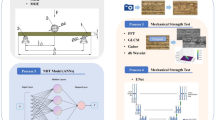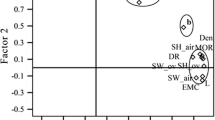Abstract
Wood failure percentage (WFP) is an important index for evaluating the bond strength of plywood. Currently, the method used for detecting WFP is visual inspection, which lacks efficiency. In order to improve it, image processing methods are applied to wood failure detection. The present study used thresholding and K-means clustering algorithms in wood failure detection, and four kinds of plywood were manufactured to analyze the influences of wood species and adhesive. Results show that the detection by K-means clustering method is more accurate than thresholding method; it could better correlate with visual inspection results, while the detection results by thresholding method could not reflect the fluctuation of visual inspection results with types of plywood. Moreover, both analyses of the influence of adhesive and wood species show that thresholding method based detection results are more affected by adhesive color, veneer color and permeability of poplar and eucalyptus veneer (mean absolute error compared with visual inspection: PF-Eucalyptus: 15.77 %; PF-Poplar: 25.42 %; UF-Eucalyptus: 30.55 %; UF-Poplar: 21.48 %); whereas K-means clustering method based detection results show no significant change as adhesive and wood species varies (PF-Eucalyptus: 11.07 %; PF-Poplar: 10.22 %; UF-Eucalyptus: 14.77 %; UF-Poplar: 8.50 %). It can be concluded that K-means clustering method has better compatibility for different adhesive and wood species in wood failure detection.






Similar content being viewed by others
References
Bao FC, Lu JX (1992) A study on fluid permeability of important Chinese woods. Scienria Silvae Sinicae 28(3):237–246
Christy AG (2005) Automated measurement of checks at wood surfaces. Measurement 37(2):109–118
Conners RW, Cho T-H, Ng CT, Drayer TH, Araman PA, Brisbin RL (1992) A machine vision system for automatically grading hardwood lumber. Ind Metrol 2(3–4):317–342
Demirkir C, Çolakoğlu G, Özsahin S, Aydin I (2013) Optimization of some panel manufacturing parameters for the best bonding strength of plywood. Int J Adhes Adhes 46(5):16–20
Dhamodaran TK, Gnanaharan R (2007) Boron impregnation treatment of Eucalyptus grandis wood. Bioresour Technol 98(11):2240–2242
Dhawan AP (1990) A review on biomedical image processing and future trends. Comput Methods Progr Biomed 31(3):141–183
Friedland KD, Ama-Abasi D, Manning M, Clarke L, Kligys G, Chambers RC (2005) Automated egg counting and sizing from scanned images: rapid sample processing and large data volumes for fecundity estimates. J Sea Res 54(4):307–316
Funck JW, Zhong Y, Butler DA (2003) Image segmentation algorithms applied to wood defect detection. Comput Electron Agr 41(1):157–179
Gonzalez RC, Woods RE (1992) Digital image processing. Addison-Wesley, USA
Gonzalo A, Estevez AP, Perez CA (2005) A neurofuzzy color image segmentation method for wood surface defect detection. For Prod J 55(4):52–58
Gonzalo A, Estevez PA, Claudio AP (2009) Automated visual inspection system for wood defect classification using computational intelligence techniques. Int J Syst Sci 40(2):163–172
Gu YH, Andersson H, Vicen R (2010) Wood defect classification based on image analysis and support vector machines. Wood Sci Technol 44(4):693–704
Harjoko A, Gasim (2010) Comparison of some features extraction method in wood identification. In: Proceedings of 2010 international conference on distributed frameworks for multimedia applications. 2010, August 2–3, Yogyakarta, Japan, pp 1–6
Hu XX, Chen P, Xu ZD (2011) The influencing factors and measuring method of the rate of wood failure. Wood Process Mech 4:15–18
Jiang YT, Jia Y, Cheng YS (2011) Analysis of relevant problems with current plywood standards and suggestions. For Mach Woodwork Equip 39(9):52–54
Kennel P, Subsol G, Gueroult M (2010) Automatic identification of cell files in light microscopic images of conifer wood. In: Proceedings of 2nd international conference on image processing theory tools and applications (IPTA), 2010, July 7–10, Paris, France, pp 99–103
Kline DE, Surak C, Araman PA (2003) Automated hardwood lumber grading utilizing a multiple sensor machine vision technology. Comput Electron Agr 41(1–3):139–155
McMillin CW (1982) Application of automatic image analysis to wood science. Wood Sci 14(3):97–105
Mekhtiev MA, Torgovnikov G (2004) Method of check analysis of microwave-modified wood. Wood Sci Technol 38(7):507–519
Pham DT, Soroka AJ, Ghanbarzadeh A, Koç E, Otri S, Packianather MS (2006) Optimising neural networks for identification of wood defects using the bees algorithm. In: 2006 IEEE international conference on industrial informatics, pp 1346–1351
Sathya B, Manavalan R (2011) Image segmentation by clustering methods: performance analysis. Int J Comput App 29(11):27–32
Wooten JR, Filip To SD, Igathinathane C, Pordesimo LO (2011) Discrimination of bark from wood chips through texture analysis by image processing. Comput Electron Agr 79(1):13–19
Xu JJ, Shen LX, Zhao GP (2010) Trabecular bone porosity measurement based on digital image processing. J Clin Rehabil Tissue Eng Res 14(17):3062–3064
Yang Y, Gong M, Chui YH (2008) A new image analysis algorithm for calculating percentage wood failure. Holzforschung 62(2):248–251
Yang HZ, Lin Y, Tang ZS (2011) The method research of counting fish spawns based on image processing. J Hydroecol 32(5):138–141
Yuan DL, Dong HJ, Tian XJ (2012) Gear surface defects measurement techniques based in image processing. J Dalian Jiaotong Univ 33(1):53–55
Zhan GZ (2000) Discussion on current situation and development prospects of plywood production in China. China For Prod Ind 27(5):7–10
Zhang HJ, Yin XM, Qiu RQ (2003) Evaluation method of adhesion effect for plywood. China Wood Ind 17(5):4–7
Zink AG, Kartunova E (1998) Wood failure in plywood shear samples measured with image analysis. For Prod J 48(4):69–74
Acknowledgments
Financial support of this study is provided by Special Fund for Forest Scientific Research in the Public Welfare (201404516).
Author information
Authors and Affiliations
Corresponding author
Rights and permissions
About this article
Cite this article
Lin, L., He, S., Fu, F. et al. Detection of wood failure by image processing method: influence of algorithm, adhesive and wood species. Eur. J. Wood Prod. 73, 485–491 (2015). https://doi.org/10.1007/s00107-015-0907-z
Received:
Published:
Issue Date:
DOI: https://doi.org/10.1007/s00107-015-0907-z




